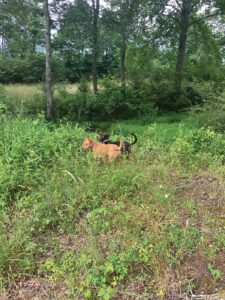The Devil’s In The Details
Jessica Louque
Most of us have our bees in fairly rural places. It can be shady, sunny, pristine, wild, in a backyard, in the woods – so many options. My neighbor has a swarm trap on his porch roof, probably to lure away our miscreant hives. Almost all of ours are in some place that will end up with muddy tires in the lightest of rains and hitchhikers stuck to your pants. Apparently, some of these places aren’t deterrent enough since we had four hives stolen from one of our study sites a week ago – must have been too close to the highway. It’s hard to not blame yourself for things like this, but really it shouldn’t matter how I had my bees to not have people steal. Anyway. My first thought of these bees when I went to check and see exactly what was stolen (they left the accompanying hive tools, lids as stands, and cinder blocks, but they were ratcheted and ready to move because we were coming to get them in the next couple days), I noticed that there was poison ivy everywhere. I hope the bee thieves are covered in bee stings and rashes. They were our most aggressive hives, after all. It made me think about how many times I’ve ended up with ivy rashes just from checking bees or wandering near them.
Eastern poison ivy is scientifically named Toxicodendron radicans and can grow just about anywhere. It can grow into just about any habit, and it can look wildly different just a few feet away from another of its own kind. When it’s tiny, it appears to be an innocent little plant with sweet soft leaves and happy little growths. Then, it starts getting bigger, bushier, or vining and can overtake trees and put kudzu to shame. The trunks of the vines can easily be larger than your forearm and produce aerial roots all over. Mowing my mom’s yard, I pushed a tree branch out of my way that made sure to gently caress my cheek on my way by. Then I realized it didn’t have the right leaves to match the rest of the tree. Then I realized again that it was not part of the tree but a poison ivy vine that was making its own branches off of the tree and just tried to eat my face. My first reaction was to use a potato peeler and just take the skin off my face because it would be better than the rash, but I just went to the bathroom and washed my face instead.
I have always been severely allergic to poison ivy. Some of our farm workers when I was younger could pull it up by their bare hands and never get anything. They used to tell me it was because they were in ‘nam and nothing else could bother them after that. I had no idea what that meant at the time, but I was definitely jealous. As I got older, it just got worse and I would have to go to the doctor for cortisone creams or steroid shots, especially if it was close to my eyes. The problem is the chemical in poison ivy called urushiol. Poison Ivy is in the Anacardiaceae family, which is pistachios, cashews, mangoes, and other toxic plants. People who are allergic to urushiol do not build up a tolerance by exposure as happens with some things (like bee stings). Instead, it causes hypersensitivity with repeated exposure and can make you more sensitive to other carriers of urushiol. This chemical can be found throughout the cashew family. Improperly treated cashews can carry it, as can mangoes. Mangoes have their own irritant that can cause a reaction, and sometimes it can cause a severe reaction by responding to urushiol as well. The fruits from this family, such as cashews, mangoes, and pistachios, all have urushiol in them. With mangoes, the chemical is found in the skin and the stalk, and little beads of urushiol can be found around the break from the tree on what used to be the flower petiole. Cashews and Pistachios are always steamed or cooked to try to remove urushiol from the nuts, and cashews are not sold with shells ever. Even with these precautions, people who are sensitive to urushiol can still have allergic reactions to these fruits and should probably avoid them. It’s an odd reaction because basically no other animal has an issue with urushiol, whether it be from lack of skin contact (fur, feathers) or just no immune system response.
Poison ivy is actually really good for local habitats. A lot of animals eat it with no ill effects. Birds eat the berries, and lots of pollinators, including bees, like the flowers. We have had poison ivy pollen show up in our pollen IDs multiple times in decent quantities. It’s really only a bad plant if it is near humans. You can get the oil from your pets, if your pet has it and you touch them. The oil is pretty aggressive and can stay on pet fur for a long time. If you get it on your skin, you have about ten minutes before it takes up permanent residence inside your epidermis. Soap and water will work to get rid of it, or some alcohol if you have it on hand. It is not water soluble so just rinsing won’t help. After that 10 minutes of grace, it’s going to be cortisone cream and Benadryl for you after about three days. It normally takes at least 48 hours for the rash to show up on people, but it can be three or four days. It normally only lasts a week, but if you’re really lucky, you’ll keep your blister rash for almost a month. It also can’t spread like some people think. You can’t catch it from other people, or spread it around your body. The rash comes up exactly where the oil touches you. Now, if you take the oil and scratch a few places, not knowing it’s on your hands, you can spread it around on yourself pretty rapidly or put it in places you might not want it to be. It’s the same with your pets. If you have dogs or cats or goats that go outside and then come in and hop on your furniture or bed, there’s a chance you’re going to end up with the rash from secondary exposure. It’s not a bad idea to wipe down your pets when they come in the house if you can. I gave up on this because we leave all our doors open and there’s just too many animals to deal with.
There are a ton of things on the market that are sold to prevent or get rid of poison ivy. I’m pretty sure most pharmacies or medicine sections have a shelf dedicated to it. These aren’t really useful. I mean, I guess they would work, but regular soap is just as good. Especially instead of something that scrubs. Never do that. You don’t want to potentially expose yourself more by causing microtears and giving the oil a free ride in your body. Regular soap is fine. Dish soap is probably better just because it’s meant to break up grease on dishes, but in general, buy yourself a drink and snack or save your money instead of buying fear products. If you already have it, nothing is going to make it go away. If you’re the hippie type or like home remedies, jewelweed is probably the best thing I’ve seen for it and I’ve bought a few variations off the internet for friends of mine that have been exposed. Just be careful with medicinal plants because you might have an allergic reaction and not expect it since you might not have been around it before. This post is inspired partly by my beautiful friend Cathia, who moved to Texas and had her kids in the emergency room with nearly necrosis after climbing trees covered in ivy and having some of the worst reactions I’ve ever heard of. Her daughter required hospitalization and both her and her little brother had to have medical intervention to keep from suffering long-term damage. Poison ivy is no joke and you shouldn’t take it lightly, even if you don’t have a reaction at the present time. As a side note, this same friend gave me a remedy with monkshood(aconite) in it for Henry’s muscle issues when he ran track and that’s how we found out he’s allergic to Aconite. Luckily the jewelweed couldn’t have made their problem much worse even if it didn’t work!
Now, in the panic to get rid of this devil plant, you may start pulling up all the ivy around your bees and house. Make sure you pay attention and leave your Virginia Creeper alone. They look pretty similar, but creeper is a great bee plant that they love and has no detrimental qualities to humans unless you just don’t like vines. They are typically a larger portion of our pollen source ID’s over the Summer than poison ivy, and would be considered an important food source. If you are particularly anti-human, you may be like me and consider putting up a fence and training poison ivy to grow on it around your property. I don’t think it would stop the bears, but at least you know where your bees went when the bears come. Either way, wash your hands and exposed skin frequently and hopefully you can avoid rashes and illness for the summertime!











